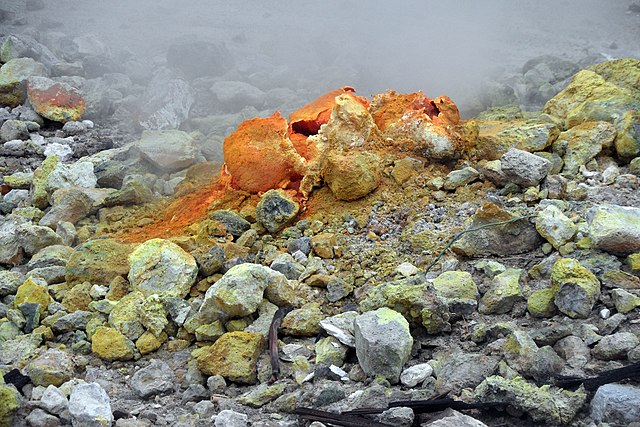Geothermal activity
Activity resulting from underground heat From Wikipedia, the free encyclopedia
Activity resulting from underground heat From Wikipedia, the free encyclopedia
Geothermal activity is a group of natural heat transfer processes, occurring on Earth's surface, caused by the presence of excess heat in the subsurface of the affected area, usually caused by the presence of an igneous intrusion underground.[1] Geothermal activity can manifest itself in a variety of different phenomena, including, among others, elevated surface temperatures, various forms of hydrothermal activity, and the presence of fumaroles that emit hot volcanic gases.

Geothermal activity mostly appears in volcanic provinces, where it is fueled by the presence of a magma chamber. In some rare cases it can be caused by underground fires or by large deposits of radioactive elements. Other sources of internal heating can be gravitational differentiation of substances, tidal friction, metamorphism, or phase transitions. The release of heat to the surface occurs either in the form of a conductive heat flow, or in the form of convective heat transfer by groundwater or gases.[2]

Fumaroles, or volcanic vents, are holes in the ground from which volcanic vapors and gases escape to the atmosphere. Geothermally active areas are often located over an active magma chamber, which constantly releases hot gases that travel to the surface through cavities in the rock. Where these cavities reach the surface they form fumaroles. Areas where these vents are concentrated are known as Fumarole fields. Fumaroles tend to form concentrated deposits of sulfuric minerals, which fall out of suspension when the volcanic gases cool to the air.[3]
Ice cauldrons are a feature that occurs when an ice cap is affected by geothermal heating, either from active volcanism or the continuous heat production from an active geothermal area. Ice cauldrons can have many different appearances. These range from a smooth dent in the ice cap to deep holes with very steep walls formed by concentric rings of crevasses. The width of ice cauldrons can range from 50 meters up to around 10 kilometers, while depth can range from several meters to hundreds of meters. The shape of the cauldron can be stable or highly variable, and is not related to the nature of the underlaying heat source.[4]
Geothermal heat and groundwater can interact in several ways.

Geysers are the most well known hydrothermal feature. they occur when groundwater in underground cavities becomes superheated under a lid of colder surface water. When the superheated water breaches the surface, it flashes to steam, causing the pressure below it to suddenly drop, which causes a chain reaction where most of the water in the geyser's feed system flashes to steam all at once.
There are two main types of geyser. Fountain geysers, which erupt in violent bursts from a pool, and cone geysers, which erupt in steady jets for minutes at a time from a sinter cone of siliceous material that has been deposited surrounding the main vent. [6]

In other areas, the heated groundwater gathers in pools, forming hot springs.[7] Where very little groundwater is available, rising hot groundwater in combination with microbial activity leads to the formation of mud pots.[8] The behaviour of these mud pots can vary on a seasonal cycle based on variations in the amount of rainfall and the level of the water table. [9][10]
Hydrothermal explosions occur when a mass of superheated water is unable to reach the surface, causing pressure underground to rise until a critical point is reached and an explosion occurs, ejecting the superheated water along with the rock. [11]
Seamless Wikipedia browsing. On steroids.
Every time you click a link to Wikipedia, Wiktionary or Wikiquote in your browser's search results, it will show the modern Wikiwand interface.
Wikiwand extension is a five stars, simple, with minimum permission required to keep your browsing private, safe and transparent.